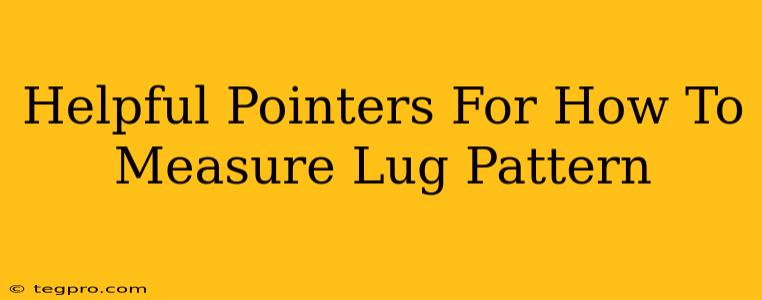Measuring your lug pattern, also known as bolt pattern, might seem daunting, but it's a crucial step for anyone working with wheels and tires. Getting this wrong can lead to serious safety issues, so accuracy is key! This guide offers helpful pointers to make the process straightforward and safe.
Understanding Lug Patterns
Before we dive into the measurement process, let's clarify what a lug pattern actually is. It refers to the diameter of the circle formed by the centers of the lug holes on your wheel and the number of lug holes. You'll need both pieces of information to find the correct replacement wheels for your vehicle.
Key Terminology:
- PCD (Pitch Circle Diameter): This is the diameter of the circle passing through the centers of the wheel's lug holes. This is the primary measurement you'll need.
- Number of Lug Holes (Studs): This is simply the count of lug holes on your wheel. Common numbers include 4, 5, and 6.
- Lug Bolt Size: While not directly part of the lug pattern, knowing the thread size and length of your lug bolts is also essential for safe wheel installation.
How to Measure Your Lug Pattern: Step-by-Step Guide
Now let's get to the practical part. Here's how to accurately measure your lug pattern:
1. Gather Your Tools: You'll only need a measuring tape or ruler and possibly a calculator (depending on your preferred method).
2. Access the Wheel: Remove the wheel from your vehicle. If you're uncomfortable doing this, take your vehicle to a trusted mechanic. Safety first!
3. Measure the PCD (Pitch Circle Diameter):
- Method 1: Direct Measurement (Most Accurate): Measure the distance between any two lug holes opposite each other. Then, multiply this measurement by two and divide it by the number of lugs. For example, if you have a five-lug wheel and the distance between opposite lugs is 100mm, you calculate (100mm * 2) / 5 = 40mm. This 40mm is not the PCD which is 140mm; therefore the formula is inaccurate. Use method 2 instead for accurate results.
- Method 2: Using a caliper (Most Accurate): Measure the distance from the center of one lug hole to the center of another lug hole. That distance x2 = PCD.
- Method 3: Using a string or flexible measuring tool (Approximation): Carefully place a string or flexible measuring tool from the center of one lug hole, across the center of the wheel to the center of the opposite lug hole. Then, double the measurement. This is least accurate but usable for approximations.
4. Count the Number of Lug Holes: This is a straightforward count! Make sure you've counted all the holes.
5. Record Your Findings: Write down both the PCD (in millimeters or inches) and the number of lug holes. This information is crucial when purchasing new wheels. For example, you might record it as "5x114.3mm" (five lug holes, 114.3mm PCD).
Important Safety Considerations
- Always consult your vehicle's owner's manual: This manual should specify the correct lug pattern for your vehicle.
- Never attempt to use wheels with an incorrect lug pattern: This is incredibly dangerous and can lead to wheel detachment while driving.
- If you're unsure about any step, seek professional help: A mechanic can quickly and accurately measure your lug pattern.
Off-Page SEO Considerations
To boost the search engine ranking of this article, consider the following off-page SEO techniques:
- Building high-quality backlinks: Reach out to relevant automotive websites or forums and share your article. Make sure the websites are reputable and relevant.
- Social media promotion: Share your article on social media platforms frequented by car enthusiasts.
- Guest blogging: Contribute articles to automotive blogs and include a link back to your article.
By following these tips, you can confidently measure your lug pattern and ensure your wheels are safely and correctly installed. Remember, safety is paramount!

